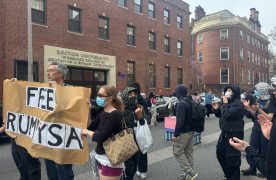Anyone that comes from a state lacking in public transportation can tell you, The Massachusetts Bay Transportation Authority, or T, as it’s universally known, is beyond convenient.
In a college town like Boston where parking costs an arm and a leg and the road design resembles a Melissa & Doug road map mat for kids, public transit is greatly appreciated. The T gets you where you need to go considerably on time and at a reasonable price — but our admiration for the system doesn’t mean we can’t ask for more, especially when its faults yield deadly consequences.
This past June, 39-year-old Robinson Lalin was killed when his arm got stuck in the doorway of a Red Line train — an incident that is a result of a circuitry issue which allowed the train to move with the door obstructed. However, sources have been cited stating that it is the responsibility of the conductor to ensure all passengers are within the vehicle before departing the station.
This incident was a direct effect of MBTA issues with personnel and hiring. The small pool of current operators have led some to work up to 16 hour shifts.
The MBTA’s safety practices are currently under investigation by the Federal Transit Administration. This investigation led the MBTA to cut back on services over the summer, implementing a typical Saturday schedule everyday of the week for the Red, Orange and Blue lines.
Beyond more internal safety concerns, the T’s problems are no stranger to the naked eye. All students in the Boston area have the shared first-year experience of entering the Boylston T stop for the first time and ducking for cover as they mistake the T’s interminable screeching for an enemy attack.

On top of this, a Tik Tok by user ratchelhill witnesses the account’s owner poking a glob of paint on a pole in the Hynes Convention Center Green Line station— an unknown green liquid subsequently gushes out.
Despite these overt problems, the MBTA’s budget falls flat by $200 million, with the system unable to depend on the COVID-19 relief funds it has used to scrape by these past couple of years.
While in Boston and the U.S. in general, inadequate public transportation is widely accepted as the norm, in other parts of the world subways aren’t inherently a risky business.
A Boston Globe article drew parallels between the Buenos Aires subway and Boston’s — two of the world’s oldest transportation systems, with Buenos Aires’ subway being built a mere 16 years after ours.
Despite great political division and inflation of 80%, the Buenos Aires subway system has a well maintained infrastructure, with very few delays and no recent incidents or general safety concerns.
Considering Boston’s comparable political and economic stability, one is forced to wonder why fixing our crumbling transportation system is not of the utmost importance to the city.
Changes can be made to fix the T.
The MBTA hopes to hire at least 32 new train operators this year, though hiring has been a problem. Of 124 applicants, 26 met the requirements and only 10 were actually selected to begin training. At least this process is proving to be as thorough as necessary, versus cutting corners and putting ill prepared trainees in the driver’s seat.
Along with this, a budgeting issue may be fixed with distance-based pay, as is used in countries like Singapore. While it can be argued this would decrease T fares, if anything, paying depending on how far you ride might encourage all riders to pay more often, rather than attempting to avoid paying at all.
There isn’t any one answer to the T’s many issues, but any step is a step in the right direction. A greater budget overall would allot the system the necessary funds to begin implementing improvements. Expectations for public transportation across the U.S are already so low, the least Boston can do is stand on its tippy toes and meet the bar all the way down in hell.
This editorial was written by Opinion Editor Lydia Evans.














